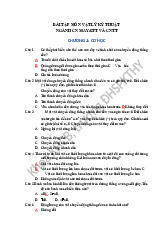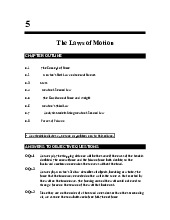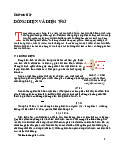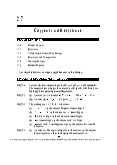



















Preview text:
lOMoAR cPSD| 58702377 27 Current and Resistance 27.1 Electric Current 27.2 Resistance 27.3
A Model for Electrical Conduction 27.4 Resistance and Temperature 27.5 Superconductors 27.6 Electrical Power
* An asterisk indicates a question or problem new to this edition.
OQ27.1 Answer (d). One ampere–hour is (1 C/s)(3 600 s) = 3 600 coulombs. The ampere–
hour rating is the quantity of charge that the battery can lift though its nominal potential difference. OQ27.2 (i) Answer (e). We require = 3 / Then = 1/3. (ii) Answer (d). 2/ 2 = 1/3 gives / = 1/ 3 . OQ27.3
The ranking is c > a > b > d > e. Because (a) /
, so the current becomes 3 times larger. (b)
2 , so the current is 3 times larger. (c)
is 1/4 as large, so the current is 4 times larger. (d)
is 2 times larger, so the current is 1/2 as large. (e)
increases by a small percentage, so the current has a small decrease. OQ27.4
(i) Answer (a). The cross-sectional area decreases, so the current
density increases, thus the drift speed must increase. lOMoAR cPSD| 58702377 Current and Resistance
(ii) Answer (a). The cross-sectional area decreases, so the resistance 2 . OQ27.10
Answer (c). Compare resistances: 2 lOMoAR cPSD| 58702377 Chapter 27
25 W bulb must have higher resistance so that it will have lower power.
(ii) Answer (b). ∆ is the same for both bulbs, so the 100 W bulb
must have lower resistance so that it will have more current. OQ27.13
Answer (d). Because wire B has twice the radius, it has four times the cross-
sectional area of wire A. For wire A, . For wire B, CQ27.1
Choose the voltage of the power supply you will use to drive the
heater. Next calculate the required resistance as . Knowing
the resistivity of the material, choose a combination of wire length and
cross-sectional area to make . You will have to pay for less material if you make both and smaller, but if you go too
far the wire will have too little surface area to radiate away the energy; then the resistor will melt. CQ27.2
Geometry and resistivity. In turn, the resistivity of the material depends on the temperature. CQ27.3
The conductor does not follow Ohm’s law, and must have a resistivity that is
current-dependent, or more likely temperaturedependent. CQ27.4
In a normal metal, suppose that we could proceed to a limit of zero
resistance by lengthening the average time between collisions. The classical
model of conduction then suggests that a constant applied voltage would
cause constant acceleration of the free electrons. The drift speed and the
current would increase steadily in time.
It is not the situation envisioned in the question, but we can actually switch
to zero resistance by substituting a superconducting wire for the normal
metal. In this case, the drift velocity of electrons is established by vibrations
of atoms in the crystal lattice; the maximum current is limited; and it
becomes impossible to establish a potential difference across the superconductor. CQ27.5 The resistance of copper
with temperature, while the resistance of
silicon with increasing temperature. The conduction electrons are
scattered more by vibrating atoms when copper heats up. Silicon’s charge lOMoAR cPSD| 58702377 Current and Resistance
carrier density increases as temperature increases and more atomic
electrons are promoted to become conduction electrons. CQ27.6
The amplitude of atomic vibrations increases with temperature.
Atoms can then scatter electrons more efficiently. CQ27.7
Because there are so many electrons in a conductor (approximately
1028 electrons/m3) the average velocity of charges is very slow. When you
connect a wire to a potential difference, you establish an electric field
everywhere in the wire nearly instantaneously, to make electrons start
drifting everywhere all at once. CQ27.8
Voltage is a measure of potential difference, not of current. “Surge” implies
a flow—and only charge, in coulombs, can flow through a system. It would
also be correct to say that the victim carried a certain current, in amperes. Section 21.1 Electric Current *P27.1
The drift speed of electrons in the line is The time to travel
the 200-km length of the line is then
Substituting numerical values, *P27.2 P27.3 We use =
, where is the number of charge carriers per unit
volume, and is identical to the number of atoms per unit volume. We assume
a contribution of 1 free electron per atom in the relationship above. For lOMoAR cPSD| 58702377 Chapter 27
aluminum, which has a molar mass of 27, we know that Avogadro’s number of atoms,
, has a mass of 27.0 g. Thus, the mass per atom is 27.0 g 27.0 g 23 23 4.49 10 g atom 6.02 10 Thus, density of aluminum 2.70 g cm3 23 mass per atom 4.49 10 g atom 6.02 1022 atoms cm3 6.02 1028 atoms m3 Therefore, P27.4
The period of the electron in its orbit is = 2 / , and the current
represented by the orbiting electron is P27.5
If is the number of protons, each with charge , that hit the target in time ∆
, the average current in the beam is / / , giving 125 10 6 C/s 23.0 s 1.80 10 16 protons 19 1.60 10 C/proton P27.6
(a) From Example 27.1 in the textbook, the density of charge carriers
(electrons) in a copper wire is = 8.46 × 1028 electrons/m3. With lOMoAR cPSD| 58702377 Current and Resistance
(b) The drift speed is smaller because more electrons are being
conducted. To create the same current, therefore, the drift speed need not be as great. P27.7 From , we have – – – – – – – – (b) Current is the same. (c)
The cross-sectional area is greater; therefore the current density is smaller. (d) 2 2 2 1 or 2 1 so 2 1 0.800 cm . (e) = 5.00 A lOMoAR cPSD| 58702377 Chapter 27 4 m2
The time between deuterons passing a stationary point is in
So the distance between individual deuterons is
= (1.38 × 107 m/s)(1.60 × 10–14 s) = 2.21 10 7 m (b)
One nucleus will put its nearest neighbor at potential
This is very small compared to the 2 MV accelerating potential, so
repulsion within the beam is a small effect. lOMoAR cPSD| 58702377 Current and Resistance (This is about 382 years!) P27.12
To find the total charge passing a point in a given amount of time, we P27.13
The molar mass of silver = 107.9 g/mole and the volume is 4 2 3 area thickness 700 10 m 0.133 10 m 9.31 10 6 m3
The mass of silver deposited is 3 3 6 3 10 kg m 9.31 10 m kg
And the number of silver atoms deposited is 23 2 6.02 10 atoms 1000 g 10 kg 107.9 g 1 kg 1023 atoms lOMoAR cPSD| 58702377 Chapter 27 The current is then Section 27.2 Resistance P27.14 From Equation 27.7, we obtain 500 mA 0.500 A *P27.15 From Ohm’s law, / , and from Equation 27.10,
Solving for the resistivity gives
Then, from Table 27.2, we see that the wire is made of silver . P27.16 . The area is 2 1.00 m 27 2 6.00 10 m 1 000 mm
From the potential difference, we can solve for the current, which gives lOMoAR cPSD| 58702377 Current and Resistance P27.17
From the definition of resistance, which yields mass density. Taking resistivity, . Thus, (b) Thus, P27.20 (a) mass density. lOMoAR cPSD| 58702377 Chapter 27 P27.21 (a)
From the definition of resistance, 13.0 (b)
The resistivity of Nichrome (from Table 27.2) is 1.50 × 10–6 m. lOMoAR cPSD| 58702377 Current and Resistance
We find the length of wire from Section 27.3
A Model for Electrical Conduction *P27.22 (a) . doubles (b) . doubles (c) . unchanged (d) as long as does not change due to a
temperature change in the conductor. 13 2 6.00 10 A m 6.00 10 15 m 1 *P27.23 so . 100 V m P27.24
(a) From Appendix C, the molar mass of iron is 3 55.85 g mol 55.85 g mol 5.58 10 2 kg mol 1 kg 10 g
(b) From Table 14.1, the density of iron is 103 kg m3 , so the molar density is molar density lOMoAR cPSD| 58702377 Chapter 27
(c) The density of iron atoms is
(d) With two conduction electrons per iron atom, the density of charge carriers is
charge carriers atom density of atoms electrons 28 atoms 2 8.49 10 3 atom m 1.70 10 29 electrons m 3
(e) With a current of = 30.0 A and cross-sectional area
= 5.00 × 10–6 m2, the drift speed of the conduction electrons in this wire is P27.25
From Equations 27.16 and 27.13, the resistivity and drift velocity can be
related to the electric field within the copper wire: and lOMoAR cPSD| 58702377 Current and Resistance 4 m/s 0.18 V/m Section 27.4 Resistance and Temperature P27.26 Solving, 1.42 103 C 20.0 C And the final temperature is 1.44 103 C P27.27
If we ignore thermal expansion, the change in the material’s resistivity – *P27.28 lOMoAR cPSD| 58702377 Chapter 27 P27.29
We use Equation 27.20 and refer to Table 27.2: *P27.31 (a) The resistance at 20.0°C is and the current is 3.01 A 0 (b)
At 30.0°C, from Equation 27.20, lOMoAR cPSD| 58702377 Current and Resistance The current is then 2.90 A 0 P27.32 (a) We require two conditions: [1]
where carbon = 1 and Nichrome = 2, and for any [2]
Setting equations [1] and [2] equal to each other, we have simplifying, (b) From Table 27.2, 1 0.5 10 3 C 1 and 1 . 0.4
Use equation [3] to solve for 2 in terms of 1 1
then substitute this into equation [1]: lOMoAR cPSD| 58702377 Chapter 27 (1.50 and so 26.2 m Therefore, 1 0.898 m and 2 26.2 m. P27.33 (a) (b) The current density is J
(d) The mass density gives the number-density of free electrons; we assume that
each atom donates one conduction electron: – – lOMoAR cPSD| 58702377 Current and Resistance
The sign indicates that the electrons drift opposite to the field and current. (e) The applied voltage is 0.200 V/m 2.00 m 0.400 V . P27.34 For aluminum, 3.90 10 3 C 1 (Table 27.2) and 24.0 10 6 C 1 (Table 19.1) The resistance is then P27.35
Room temperature is 0 = 20.0°. From Equation 27.19, 1 3 Al 0 Al Al 0 0 Cu
Then, substituting numerical values from Table 27.2 gives
and solving for the temperature gives
where we have assumed three significant figures throughout. Section 27.6 Electrical Power *P27.36 (a) 300 103 J C 1.00 103 C s 3.00 108 W lOMoAR cPSD| 58702377 Chapter 27
A large electric generating station, fed by a trainload of coal each day, converts energy faster. (b) 1 370 W m2 (6.37 106 m)2 1.75 1017 W
Terrestrial solar power is immense compared to lightning and
compared to all human energy conversions. *P27.37 , P27.38 From Equation 27.21, 103 V 7.50 W P27.39 (a) From Equation 27.21, 103 W 8.33 A (b) From Equation 27.23, 120 V 103 W 14.4 P27.40 From Equation 27.21, P27.41 From Equation 27.21, 6.00 V 2.10 W P27.42
If the tank has good insulation, essentially all of the energy electrically
transmitted to the heating element becomes internal energy in the
water: internal electrical . Our symbol (electrical) represents the same thing as the
textbook’s ET, namely electrically transmitted energy. Since internal and
where = 4 186 J/kg · °C the resistance is lOMoAR cPSD| 58702377 Current and Resistance The final current is 0.972 A The power during the surge is 136 V So the percentage increase is 136 W – 100 W 0.361 36.1% 100 W P27.44
You pay the electric company for energy transferred in the amount 7 d 24 h k 0.110 $ 2 weeks 1 week 1 d 1 000 kW h $ 0.005 34 3 min



